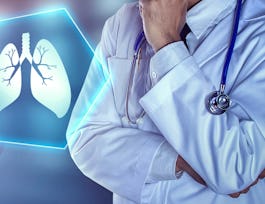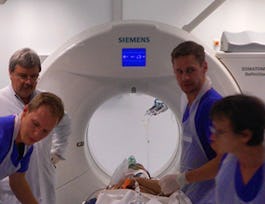Cardiovascular diseases are – according to the (World Health Organization (WHO) – the number one cause of death globally. Myocardial infarction (heart attack) is the most prominent under the Cardiovascular diseases. In Switzerland alone, the risk to develop a coronary heart disease during life time is around 25% for men and 18% for women.


Myocardial Infarction
Taught in English
Some content may not be translated
30,972 already enrolled
(388 reviews)
Details to know

Add to your LinkedIn profile
27 quizzes
See how employees at top companies are mastering in-demand skills


Earn a career certificate
Add this credential to your LinkedIn profile, resume, or CV
Share it on social media and in your performance review

There are 5 modules in this course
This first module of this course focuses on the heart and the cardiovascular system. The first lecture covers the anatomy and function of the heart, explaining the basic glossary which you will encounter during this course. The second lecture displays the various types of blood vessels and arteries. This is helpful to understand the final lecture of this module: the sympathetic nervous system. This lecture will discuss the external influences that have a direct impact on our nervous system, including the physiological effects and clinical consequences.
What's included
3 videos1 reading4 quizzes1 discussion prompt
Whereas the first module focuses on different physiological aspects of the heart and the cardiovascular system, the second module considers several external risk factors which can cause a myocardial infarction. This module not only discusses the risks such as aging, smoking, hypertension, lipids and diabetes, but also explains which preventive measures can be employed to minimize the risk of a heart attack, for example, by focusing on physical exercise to increase life expectancy and the personal health.
What's included
8 videos5 readings7 quizzes
This module focuses on different methods and approaches to deal with acute coronary syndrome, which in the worst case can lead to an acute heart attack. To provide you with a clearer idea of what can lead to myocardial infarction, this module concentrates on a variety of specific cardiac diseases, their mechanisms, the medical tools used to detect them, as well as on the appropriate therapeutic approach to prevent cardiac events.
What's included
6 videos3 readings7 quizzes
Module four illustrates the methods employed to improve cardiac rehabilitation. Moreover, this module focuses on the secondary prevention to avoid the risk of myocardial infarction. This involves the analysis of external and biological factors which can cause cardiac diseases and explains the mechanisms needed to change bad behavioral patterns. There are several factors in life which can be easily altered to improve the personal wellbeing and those are discussed in this section.
What's included
3 videos3 readings3 quizzes
The last module focuses on the pathophysiological aspect of heart diseases by illustrating the chain of cause of heart failure. The module also explains how we can diagnose a potential heart failure by correctly analyzing the clinical symptoms and signs. Echocardiography is the most important tool to identify the condition of the heart and to diagnose heart failure. To minimize the risk of heart failure, it is important to inform the patients about possible therapeutic approaches. Therefore, the last part of this module discusses both medical and device therapies and introduces assist devices in correlation with transplantation as last possible treatment method.
What's included
5 videos4 readings6 quizzes
Instructor

Offered by
Recommended if you're interested in Patient Care

Tecnológico de Monterrey

Tecnológico de Monterrey

Tecnológico de Monterrey

Technical University of Munich (TUM)
Why people choose Coursera for their career




Learner reviews
Showing 3 of 388
388 reviews
- 5 stars
84.83%
- 4 stars
11.82%
- 3 stars
2.05%
- 2 stars
0.77%
- 1 star
0.51%
New to Patient Care? Start here.

Open new doors with Coursera Plus
Unlimited access to 7,000+ world-class courses, hands-on projects, and job-ready certificate programs - all included in your subscription
Advance your career with an online degree
Earn a degree from world-class universities - 100% online
Join over 3,400 global companies that choose Coursera for Business
Upskill your employees to excel in the digital economy
Frequently asked questions
Access to lectures and assignments depends on your type of enrollment. If you take a course in audit mode, you will be able to see most course materials for free. To access graded assignments and to earn a Certificate, you will need to purchase the Certificate experience, during or after your audit. If you don't see the audit option:
The course may not offer an audit option. You can try a Free Trial instead, or apply for Financial Aid.
The course may offer 'Full Course, No Certificate' instead. This option lets you see all course materials, submit required assessments, and get a final grade. This also means that you will not be able to purchase a Certificate experience.
When you purchase a Certificate you get access to all course materials, including graded assignments. Upon completing the course, your electronic Certificate will be added to your Accomplishments page - from there, you can print your Certificate or add it to your LinkedIn profile. If you only want to read and view the course content, you can audit the course for free.
You will be eligible for a full refund until two weeks after your payment date, or (for courses that have just launched) until two weeks after the first session of the course begins, whichever is later. You cannot receive a refund once you’ve earned a Course Certificate, even if you complete the course within the two-week refund period. See our full refund policy.


